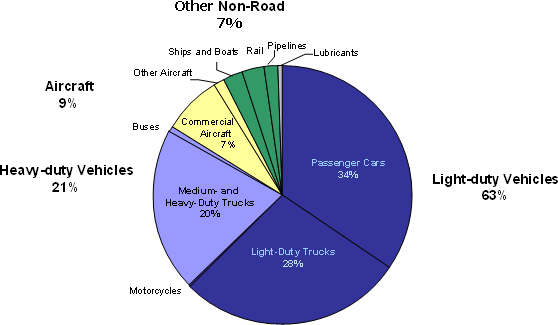Transportation and Climate Change Clearinghouse
Transportation and Greenhouse Gas Emissions
Virtually all human activities have an impact on our environment, and transportation is no exception. While transportation is crucial to our economy and our personal lives, as a sector it is also a significant source of greenhouse gas (GHG) emissions.
Based on current GHG emission reporting guidelines, the transportation sector directly accounted for about 28 percent of total U.S. GHG emissions in 2006, making it the second largest source of GHG emissions, behind only electricity generation (34 percent). Nearly 97 percent of transportation GHG emissions came through direct combustion of fossil fuels, with the remainder due to carbon dioxide (CO2) from electricity (for rail) and Hydrofluorocarbons (HFCs) emitted from vehicle air conditioners and refrigerated transport. Transportation is the largest end-use sector emitting CO2, the most prevalent greenhouse gas. Estimates of GHG emissions do not include additional "lifecycle" emissions related to transportation, such as the extraction and refining of fuel and the manufacture of vehicles, which are also a significant source of domestic and international GHG emissions.
Percentage of U.S. Greenhouse Gas Emissions, 2006 (all gases, in Teragram [Tg] CO2 equivalent)
When emissions from electricity are distributed to economic sectors, industry accounts for the largest share of U.S. greenhouse gas emissions (nearly 29 percent), followed closely by emissions from transportation activities (28 percent of total emissions). The commercial and residential sectors are also responsible for a substantial portion of emissions, each responsible for 17 percent of the total when emissions from electricity are distributed, due to their relatively large share of electricity consumption.
Since 1990, transportation has been one of the fastest-growing sources of U.S. GHGs. In fact, the rise in transportation emissions represents 48 percent of the increase in total U.S. GHGs since 1990.
U.S. Greenhouse Gas Emissions by Sector, 1990-2006 (all gases, in Tg CO2 equivalent)
 DSource: http://www.epa.gov/climatechange/emissions/downloads/08_CR.pdf (pg 50 of 473; Figure ES-13)
DSource: http://www.epa.gov/climatechange/emissions/downloads/08_CR.pdf (pg 50 of 473; Figure ES-13) U.S. Transportation Greenhouse Gas Emissions by Source, 2006 (all gases, in Tg CO2 equivalent)
The largest sources of transportation GHGs in 2006 were passenger cars (34%) and light duty trucks, which include sport utility vehicles, pickup trucks, and minivans (28%). Together with motorcycles, these light-duty vehicles made up about 63% of transportation GHG emissions. The next largest sources were freight trucks (20%) and commercial aircraft (7%), along with other non-road sources (which combined, totaled about 7%). These figures include direct emissions from fossil fuel combustion, as well as HFC emissions from mobile air conditioners and refrigerated transport allocated to these vehicle types.
It is important to note that fuel consumed in international travel by aircraft and marine sources is not counted in national greenhouse gas inventories. However, international trade has been growing rapidly, thus increasing the role of transportation as a source of global emissions.
Aircraft can have some unique and complex effects on the atmosphere due to the release of emissions and water vapor at high altitude. For instance, jet aircraft create condensation trails, or contrails, at cruise altitude in the upper atmosphere due to the combination of water vapor in aircraft engine exhausts and the low ambient temperatures that often exist at these high altitudes. Contrails affect the cloudiness of the earth's atmosphere, and therefore might affect atmospheric temperature and climate.




